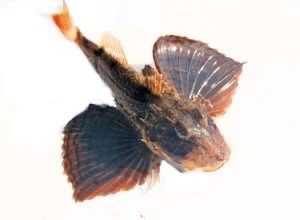Flying Gurnard

Species Details
Dactylopterus Volitans
Dactylopteridae
Scorpaeniformes
Reefs
3 - 4 lbs.
18" - 20"
Flying Gurnard (Dactylopterus volitans) Fish Description
Also known as the helmet gurnard, grunt fish, and batfish, the Flying Gurnard is a beautiful and peculiar species of fish. It has bright, colorful fan-like “wings” which are its big pectoral fins. The front part of their unusual pectoral fins looks like the foot of an amphibian; thus, the Flying Gurnard may appear like a member of the lizard family. It also has prominently large eyes rimmed with a bright orange color.
The Flying Gurnard’s body is elongated and greenish or brownish in color; it has yellowish or reddish patches. Its blunt and huge head is covered with bony plates or scute-like scales that have sharp keels. It has a single dorsal fin ray found at the nape of its neck. The Flying Gurnard possesses 6 anal soft rays, 7 dorsal spines, and no anal spine.
Diet and Size
The Flying Gurnard loves crustaceans (crabs and shrimps), bivalves (clams), and small fishes.
The Flying Gurnard can measure up to 20 inches and weigh up to 4 pounds.
Interesting Facts About the Flying Gurnard
- The Flying Gurnard spreads its semi-transparent wings when it gets excited. Its colorful wings have a phosphorescent electric blue coloration at the edges.
- When looking for prey, the Flying Gurnard “walks” on the sandy ocean floors by using its pelvic fins.
- The Flying Gurnard uses its fantastic pectoral fins or “wings” to fan out or scare away predators.
- Unlike the flying fish, the Flying Gurnards cannot glide nor fly in the air. However, they can glide on the surface of the water for a short period using their widespread pectoral fins.
- The French word gurnard means ‘grunt’. Like the sea robins or true gurnards, the Flying Gurnards produce growling sounds using their swim bladder and drum muscles. Some scientists believe that they use these sounds to communicate with one another.
- The opportunistic feeder fishes like the yellow jack and coney usually accompany the Flying Gurnard.
- The Flying Gurnard is a distant cousin of the venomous scorpionfish; however, the Flying Gurnard is not deadly like the scorpionfish.
Fishing Techniques
The Flying Gurnard population is fairly good; they are not generally fished commercially except in Senegal. However, the Flying Gurnard is a famous game fish for anglers. They are also usually captured and sold as aquarium fish. Luckily for the anglers who want to capture this captivating fish, the Flying Gurnard is labeled as a species of Least Concern by the IUCN.
Habitat and Distribution
Flying Gurnards thrive in tropical waters especially in the temperate parts of the Atlantic Ocean as warm as 72-78° F. They are usually found on muddy, sandy, and rocky areas at the bottom of the ocean as deep as 328 feet, especially when they are foraging for food. Despite being bottom-dwellers, the eggs of Flying Gurnards usually freely float on the surface.
Flying Gurnards inhabit the waters of Massachusetts to Canada, the Caribbean, the Gulf of Mexico, and Argentina; they are native to the Indo-Pacific. They can also be found in the Mediterranean, and from the English Channel to Angola.



